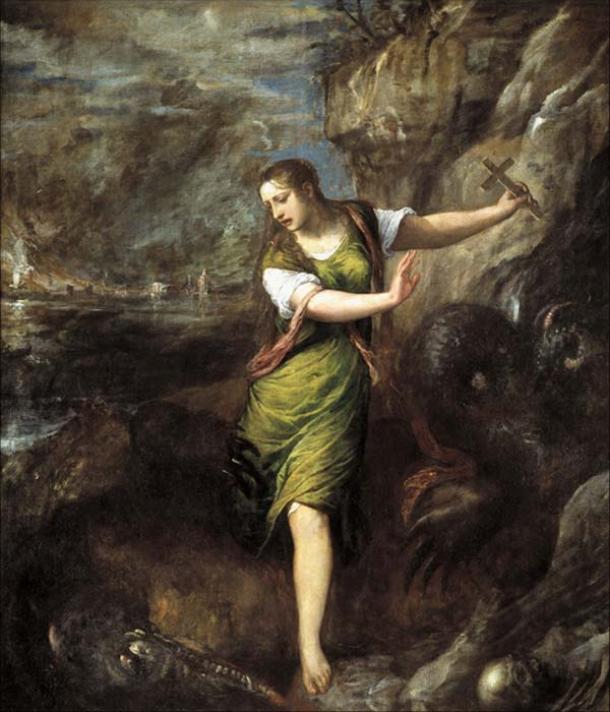St Margaret of Antioch
Saint Margaret’s Church in Hawes is considered to be dedicated to Saint Margaret of Antioch

St Margaret and the Dragon by Titian – Prado Museum
Nothing certain is known of her, but according to an untrustworthy legend compiled in the 13th Century, she was the daughter of a pagan priest called Theodosius in Antioch of Pisdia (Turkey) in the 3rd and 4th Century. Her mother had died in childbirth. Also known a Marina, she was converted to Christianity whereupon she was driven out of her home by her father. She lived in the country 6-8 miles outside Antioch, with a nurse as a foster-mother and she became a shepherdess. When she was 15, Olybrius, a Prefect under the Roman Emperor Diocletian, was infatuated with her beauty and he asked her to marry him.
However, the condition was that she renounced Christianity. Upon her refusal, he had her tortured and then imprisoned. Marina frankly replied to the man: “Have no vain hope for me, O governor, that I might cower before any number of torments. Nothing will separate me from Christ – neither affliction, famine, fire, sword, nor any other harsh tribulation – not even a violent and very painful death. (see Romans 8 v 35ff)
While she was in prison she was believed to have had an encounter with the devil in the form of a dragon. According to the legend, he swallowed her, but the cross she carried in her hand so irritated his throat that he was forced to disgorge her. The next day, attempts were made to execute her by fire and then by drowning, but prayers kept her unharmed and she was miraculously saved. Thousands of spectators who witnessed her ordeal were converted to Christianity – all of whom were promptly executed. Finally, she was beheaded at the age of 16 in AD 304. Her remains are considered to have been initially at Panteponteia Monastery and maybe later transferred to Italy and then to Athens.
That she existed and was martyred may be true; all else is probably fictitious embroidery that adds to her legend. At various times the Roman Catholic Church denounced her, suggesting that she had never existed, however during the time of the crusades and into the Middle Ages, she became popular in Western Europe. She was one of the fourteen ‘Holy Helpers’ whom the Roman Catholics believe would pray for people in need. Joan of Arc believed that she heard the voice of Margaret of Antioch encouraging her in her mission to the French King. Her victory over the dragon led to her being regarded as a protector against demonic powers.
The cult of Saint Margaret became very widespread in England, where more than 250 churches are dedicated to her, including 48 in Norfolk, but her cult was suppressed by the Roman Catholic Church in 1969 as they doubted that she had ever existed. She is considered to be the patron saint of pregnant women and childbirth, of dying people, nurses and people in exile and of peasants.
In art she is sometimes represented as a Shepherdess or, as on our church banner, pictured standing on the dragon.
Her feast day is celebrated on 20th July in the West and in the East on July 13th.
Judgements about what we can believe of the story of Margaret need to be understood in the light of the truths that we believe from scripture. Jesus and only Jesus is the one who intercedes for us and in him only is salvation found.
Christ Jesus, who died – more than that who was raised to life,
is at the right hand of God and is also interceding for us.
Romans 8 v 34
Peter talking before the Jewish legal court and speaking of Jesus says:
‘Salvation is found in no-one else,
for there is no other name under heaven given to men by which we must be saved’
Acts 4 v 12
Acknowledgements:
An earlier church pamphlet (authors unknown)
Encyclopaedia Britannica
Mike Hirst
; ?>/images/cross.png)
